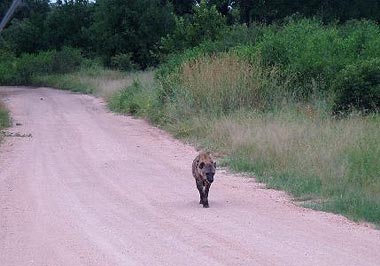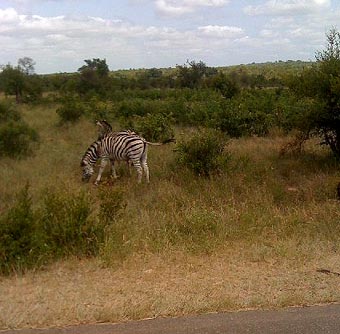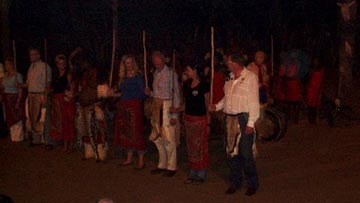| The Journal of Provincial Thought |
|
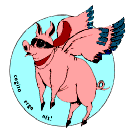 |
|||||||||||
| John Rice | ||||||||||||
| Hatari It Isn't Part 2 (contin., page 3) | to page 1 | |||||||||||
| to page 2 | ||||||||||||
| ________________________________________________ | ||||||||||||
|
Not far down the road, we turned off the pavement and headed deeper into the countryside on a dirt track. Soon we encountered a group of hyenas crossing the road, no doubt to find something to laugh about on the other side.
Lone hyena, trying to remember the punch line Baboons were a common sight in the park, always trooping across the road, looking around furtively as if they were criminals coming from the scene of the crime, checking out who might have seen them. |
||||||||||||
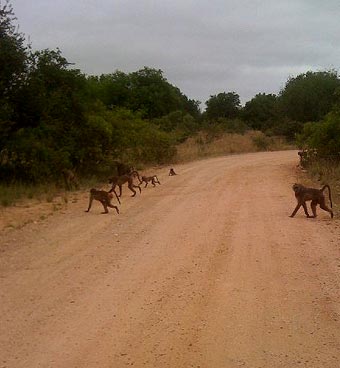 |
It wasn't me, copper, I was in the grass picking fleas when it happened | |||||||||||
|
Warthogs were feeding in the tall grass, thin brush–topped tails straight up in the air, much like young toughs on a street corner looking for trouble. With their exaggerated shoulders and chests, narrow hips and fierce expressions, one could almost imagine them with cigarette packs rolled up in their sleeves and tattoos reading “Mother” on massive biceps. When they turned to watch us, I could hear one saying, "Hey...what’re you looking at?" Zebras, the traditional horse in striped pajamas, wandered across the road and stood together much like their American cousins are wont to do in the pastures of central
Stripes are in this year. The plaid thing didn't work so well for them Alfred braked suddenly to a halt, then reversed about fifty feet. There on the open plain, a short distance from the track, were three black rhinos sound asleep in a clearing. He told us that there were only about 300 of the great prehistoric beasts left, so seeing three in a group was a rare treat. We watched them for a while sleeping peacefully unconcerned there in the park. While some of the world's largest and most formidable predators are also there in Kruger, something the size of an Escalade, like the black rhino, doesn’t have a lot to be afraid of. About another half mile down the track, we paused at a bridge over a mostly dry creek bed. There, a pair of white rhinos, accompanied by some impala, grazed quietly. The white rhino (not really the color white, more of a dull gray—the “white” comes from an Anglicization of the Dutch word for “wide,” distinguishing the face from the sharper, narrower face of the black rhino) is larger than the black and is the one you probably think of when and if the term “rhinoceros” comes to mind. We continued on, in search of the rest of the “Big Five” (rhino, hippo, lion, cape buffalo and leopard), but the others remained in hiding for the day. We did see two species of eagle: one the bardolier black eagle, a stockier cousin of our national symbol, without the white head; and another, the martial eagle, a black bird with a feather pattern that makes it appear that he’s wearing white suspenders.... or maybe he is. After returning to Numbi Lodge, we saddled up again and rode to the nearby town of |
||||||||||||
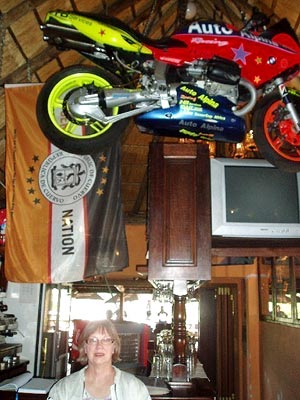 |
Brenda, hoping the cables are sufficient to hold the bike | |||||||||||
|
Lunch on the deck completed, we rode a short way through the mountains to Pilgrim’s Rest,* a mining community from the gold-mining heyday (remember poor old Tom Burke?) now preserved as a sort of monument/ tourist center. The old buildings have been kept as in the early days but now are used as shops and restaurants and museums. Gold is still mined in the area, but using much more modern techniques than the picks and shovels and horse-drawn carts of yesteryear. That night we went to a local resort compound for our "cultural experience," a show put on by members of the Shangana tribe that once lived in what is now
Tamzin shows them how it's done After the show there was a buffet dinner of African foods and desserts. I was introduced to, among other delicacies, "Koeksisters"—a twisted pastry soaked in honey, sort of a cross between baklava and a cruller—which I later learned was a favorite of Nelson Mandela. It's good to know that one of my heroes had similar tastes in pastry. In the river that ran through the area where the show was held, there were hippos grazing on the bottom. I saw one raise its head briefly, then duck back down to continue feeding. As we were leaving the compound, we were told to stay to a particular path because the hippos were out on the riverbank. Apparently they are one of the leading killers of humans in |
||||||||||||
* Our bro Pilgrim  gets around —ed. gets around —ed. |
||||||||||||
|
Next issue we continue our Africa run with John Rice, Esq.
|
||||||||||||
| To top |
||||||||||||
|
||||||||||||
| Copyright 2011- WJ Schafer & WC Smith - All Rights Reserved | ||||||||||||
